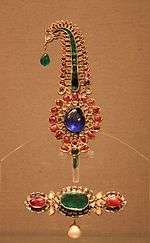Jadau

Jadau Jewellery forms one of the major examples of high skilled craftsmanship which originated in Indo-Gangetic plains. Historically speaking, the tradition of Jadau work has been in practice in the states of Rajasthan and Gujarat since the Mughal Era. Jadau jewellery is also called Engraved Jewellery and is unique and a kind in itself. Considered to be a traditional jewelry of India, it is used in many traditional and auspicious occasions, like marriages and festival celebrations.
Jadau work is teamwork, where a group of craftsmen are involved together. Each craftsman carries out a specific task related to the jewelry creation. The Chiterias make the basic design, Ghaarias are responsible for engraving and making holes, Meenakari or Enameling is done by the enameler and the goldsmith takes care of the kundan or the gold. These days, Jadau is done on not just jewellery, but also jewellery boxes and delicate showpieces.
History
It is little known but is a fact, that the most complicated and intricate 'Jadau' or diamond & Meenakari handwork in Jewellery, had been the original tradition of Bikaner. The oldest jewellery tradition of Bikaner 'Jadau' work. The total process need much handwork and caution. Suppose, 4-5 diamonds are to be fitted in a necklace, it needs a whole day to compete the job. Though this type of Jewellery is created in Jaipur, Ahmedabad and other cities but this tradition belongs to Bikaner which is its home and the people from the place had shifted to Other places. The speciality of 'jadau' handwork is the oldest one but still remains the choice of jewellery lovers. Others may do this 'Jadau' & 'Meenakari' on Jewellery but there is no match still of Bikaner where 15000 people are engaged in creating the excellence in jewellery with diamonds which is possible only by using pure 24 carate gold. This traditional jewellery includes 'Tewata or Timaniya' (Necklace) 'Bangari', 'Gajre', different type of 'Kare' used by male as women use Bangles. Peacock type Kare or ornaments used over head traditionally by women. When diamond work is completed, the meenakari starts.
Process
Though the art was first produced in Indo-Gangetic plains, jewelry craftsmen made it popular adding various regional their skills. In Jadau jewellery, precious and semi precious stones, gems, crystals and beads are embedded in gold, , embedded in gold, which is first melted a bit. When the gold becomes pliable, the stones are set on it with great precision and artistry. After that, it is allowed to cool down and the stones and gems get fixed on it without any adhesive or carvings.
Uncut diamonds called Polki or Vilandi are used as the central stone. Meenakari or art work done at the back of the jewel is purely for beautifying purposes. Highest care and attention is given towards the detail on every piece that the master craftsman creates. The stone setters first set the stone in silver foil, then fuse with a finishing of pure gold.
It is a very enjoyed work development